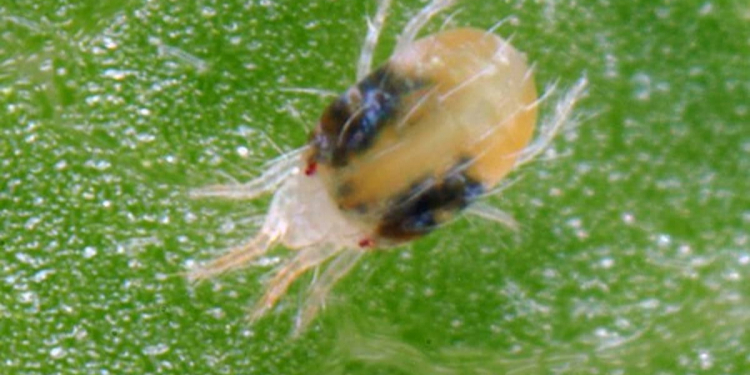Last year, arable farmer Roelof Kunst gained experience with the predatory mite Neoseiulus californicus, or Spical, as a control agent for spider mites in his potato crop. He is satisfied with the results and will use the product on a larger surface this year.
“It seems to be damage from desiccation, but if you look more closely at the browned plants, you can see that it is the bean spider mite. It can eat away all the foliage in four weeks and that costs a lot of production.” That’s what Roelof Kunst says, who has an arable farm of 120 hectares just outside Gieten in Drenthe. Starch potatoes, sugar beets, seed potatoes and grains form the building plan.
Last year he was approached by Agrifirm. The company wanted to gain practical experience with Spical van Koppert in combating spider mites in potatoes. Was Roelof Kunst perhaps interested in participating?
The entrepreneur did not have to think long. Spider mites in potatoes have been a problem for about twenty years. “But in recent years it has gotten out of hand more often. With chemistry there is not much you can do about it. I wanted to try it.”
Spical and Spical Ulti-Mite
Roelof Kunst decided to protect four hectares of his starch potatoes – a plot of 200 by 200 meters – with Spical on a trial basis. Because spider mites invade the crop from host plants at the edges of the plot, it was important to protect the outer rows of potato plants.
In those rows, around the longest day, a bag of Spical was hung in the plants every five meters; later Spical Ulti-Mite was also used. This is the same predatory mite Neoseiulus californicus , but in a bag that protects it better against moisture and drought, so that the population remains more vital and comes out of the bag over a longer period of time. “At first I thought it would be a lot of work to hang out,” says Roelof, “but in the end it was not that bad. All together it was about 160 bags. That is still doable.”
Preventive use also possible
The arable farmer is satisfied with the effect of Spical. He saw much less spider mites in the outer four or five rows in 2020, or as he says: “Brown foliage was visible here and there, but significantly less than in other years. Spical apparently cleared the bean spider mite well from the plot while I had deliberately chosen a spider sensitive variety.”
It is good to keep the protection up to standard and to introduce the predatory mite repeatedly, says consultant Frank Druyff of Koppert. “The weather can be bad, think of a heat wave, and then the predatory mite can get a hit. The army of combatants is then temporarily weakened.”
He also points out the important possibility of introducing the predatory mite as a preventive measure. ” Neoseiulus californicus is a ‘generalist’. After hanging out, it can immediately start developing its population on pollen, for example. Then it is already strongly present the moment the bean spider mite presents itself.”
It is also useful, says Roelof Kunst, not to hang the bags too low in the plant. “Mice find the bags attractive, so a higher spot is better. The mice can’t reach them.”
Cost savings possible
As said, Roelof Kunst is satisfied with the results with Spical. This year he will repeat the test, but this time on a larger surface. He is thinking of 13 hectares.
Meanwhile, Koppert is studying the possibility of introducing the predatory mite in a different way. Frank Druyff: “On larger or much larger plots, manually setting out takes more time. We are looking at the possibility of setting out the pest control via, for example, a module on the spray boom.”
Fokko Prins of Agrifirm points out another point. He calculates that using Spical can be cheaper than a chemical alternative. “This involved 160 bags on four hectares, which comes down to about twenty euros per hectare, times three introductions is sixty euros per hectare for the entire season. One chemical spraying quickly costs 85 euros per hectare. Count out your profit. By the way, it increases on larger or much larger plots or if several chemical sprays are needed in one season.”
Arable farming is working on biological alternatives
Interest in biological crop protection is growing in Dutch arable farming. Until ten years ago, new chemical agents were regularly introduced to the market. But after that the package started to shrink. Fokko Prins of Agrifirm: “As a result, there are gaps in the strategy. Biology must provide alternatives and we are investigating these for our arable farmers.”
Agrifirm is collaborating with Koppert and the research on this. The focus is on, among other things, the bean spider mite in potatoes, on biostimulants in beet cultivation, on the effect of Spidex Vital on spider mites infested potato plants and on the use of Trianum (see elsewhere in this edition) in a range of crops.



